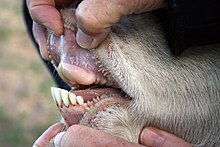Dental pad
Appearance

Thedental padorbrowsing padis a feature ofruminantandcamelids[1]dental anatomy that results from a lack of upperincisorsand helps them gather large quantities of grass and other plant matter.[2][3]This feature can be found in ruminants such ascattleandsheep.In cattle, thetongueis used to grasp food and pinch it off between the dental pad and the lower incisors. However, since they cannot bite grass off, they are inefficient at grazing more closely than 6 inches (15 cm) from the ground.[3][4]
References
[edit]- ^Niehaus, Andrew (2022),"Tooth Root Abscess",Comparative Veterinary Anatomy,Elsevier, pp. 1013–1019,doi:10.1016/b978-0-323-91015-6.00089-3,ISBN978-0-323-91015-6,retrieved2023-10-29
- ^Rouge, Melissa (2001)."Dental Anatomy of Ruminants".Colorado State University.Retrieved5 May2010.
- ^ab"Toothless cud chewers, To see ourselves as others see us."WonderQuest.Retrieved5 May2010.
- ^Hall, J.B."Nutrition and Feeding of the Cow-Calf Herd: Digestive System of the Cow".Virginia Cooperative Extension. Archived fromthe originalon 16 June 2010.Retrieved5 May2010.
